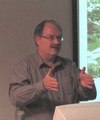United States EPA funds creation of Center for Infrastructure Modeling & Management: “British Columbia experience in whole-system, water balance based approaches in the Pacific Northwest adds a critical combination of tools and understanding to the water resources toolbox,” states Dr. Charles Rowney, Director of Operations

“It is the combination of diverse needs, ideas and solutions that will make the vision for the Center work,” stated Dr. Rowney. “That is one of the reasons we’re so pleased with the agreement just reached with the British Columbia Partnership for Water Sustainability. We have many needs in common, and many ideas to share. The leadership shown by the Partnership has led to a body of knowledge from which others can learn.”










 “We are using the slogan The New Business As Usual to convey the message that, for change to really occur, practices that until now have been viewed as the exception must become the norm moving forward. We have to build regulatory models and develop models of practice and expertise,” stated Dale Wall, Deputy Minister.
“We are using the slogan The New Business As Usual to convey the message that, for change to really occur, practices that until now have been viewed as the exception must become the norm moving forward. We have to build regulatory models and develop models of practice and expertise,” stated Dale Wall, Deputy Minister.